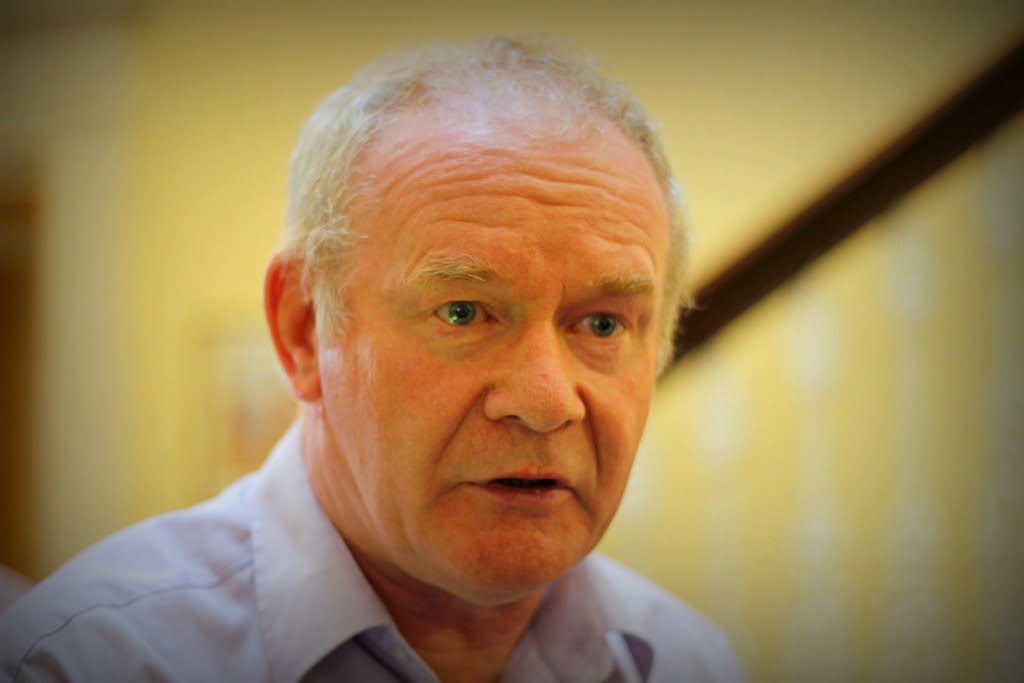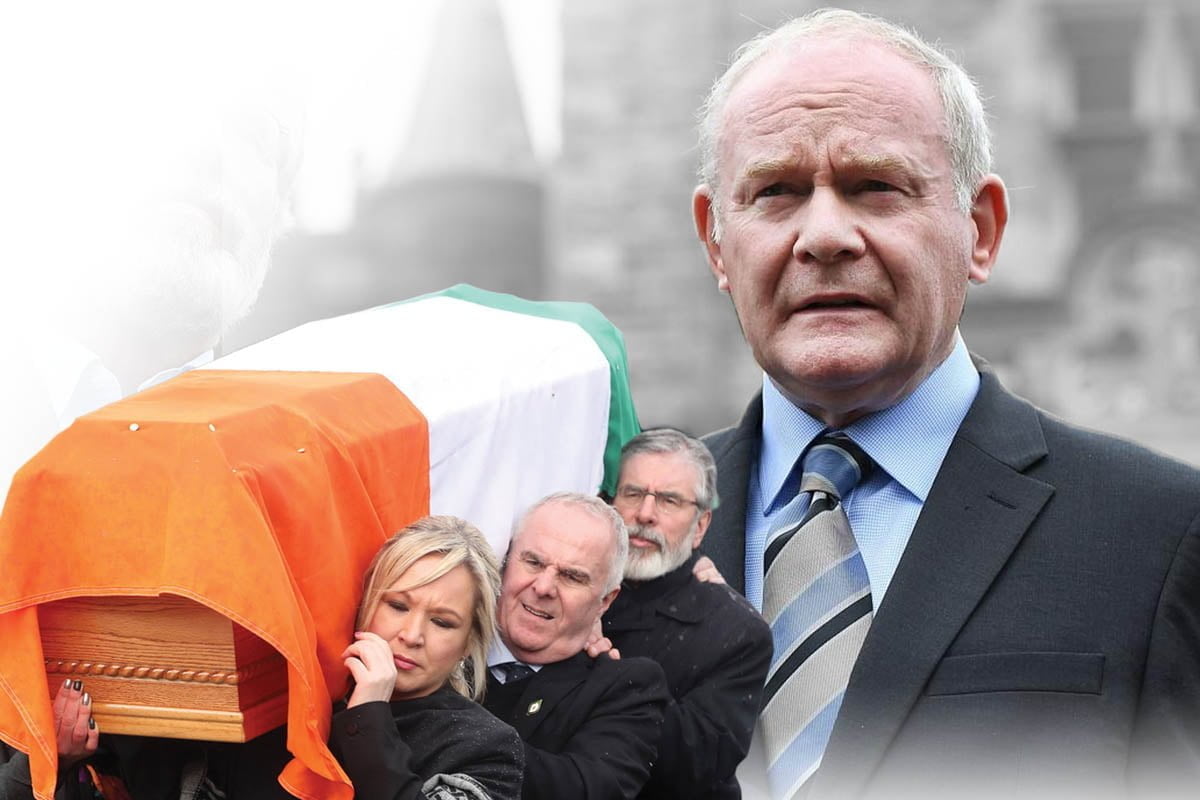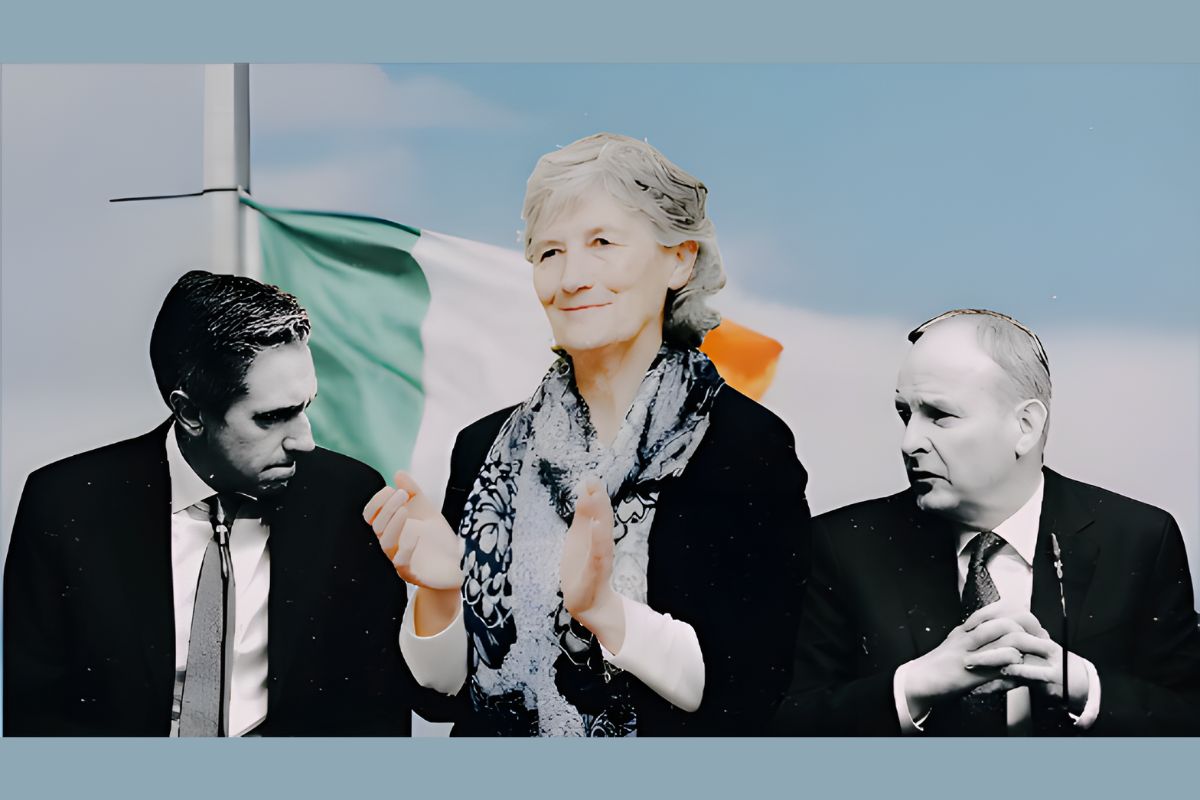Gerry Ruddy looks back at the life of Martin McGuinness, the former Provisional IRA leader, head of Sinn Féin in the North of Ireland, and Deputy First Minister in the Stormont Assembly, who passed away last week. McGuinness’ death comes at a turbulent time for the North of Ireland, as all the old divisions threaten to re-emerge in the wake of Brexit.
In the traditional Irish rural community of yesteryear there was a saying, “never speak ill of the dead”. Martin McGuinness’s body was scarcely cold before the keyboard “warriors” were launching attacks on his reputation.
In the ensuing days from his death those from a unionist background, with a black and white attitude, have simply condemned him as a “terrorist”. Meanwhile the Great and the Good in the corridors of power and influence in the USA, the UK and the European Union were lauding his statesmanlike shift from “terrorist” to “peacemaker”.
There is no doubt that Martin McGuinness divided people. But his life and his political journey hold lessons for all those who wish to change things. It is better to analyse rather than eulogise or berate. Martin was a product of his environment and his ideas and actions were shaped by the kind of society he grew up in and its historical past.
Imperialist partition
Ireland was occupied by Britain for centuries and was only conceded an element of independence following the 1916 uprising and the guerrilla war pursued by Michael Collins and the IRA up to 1921. However, they partitioned the island, leaving northern nationalists under Unionist domination.
Martin McGuinness was born in 1950 and grew up in a working class nationalist district of Derry City in an area called the Bogside beneath the walls of Derry City, then under Unionist control despite a Catholic/Nationalist majority in the City. At the time of his birth the Northern Ireland State had been in existence for a mere 30 years.
The partition of Ireland by the British State was to ensure that British long term strategic economic and political interests were safe-guarded. The deliberate partition of the isle was to ensure a permanent Unionist majority in the new Northern Ireland State. The new Unionist government, to ensure their control, abolished proportional representative voting and gerrymandered electoral wards. In local government elections they did this by introducing the “property franchise” (i.e. only those paying rates, owners of property could vote), while businesses could have six votes. This weighted representation heavily in favour of the Protestant community, leading to many towns with a Catholic majority coming under Unionist control. Hence, for example, the poor housing record in nationalist areas.
Also the Unionist government openly discriminated against Catholics. Educated Catholics would apply to join the Imperial Civil Service rather than the Northern Ireland Civil Service where promotion for Catholics was severely restricted. In the Stormont parliament itself the nationalist opposition was treated with contempt. Only one Bill proposed by the nationalists – on a wildlife issue – was passed in the 1930s. Furthermore in the mid-sixties as Martin was coming into adulthood the Unionist government decided to build a second University in mainly Protestant Coleraine rather than in the recommended and mainly Catholic City of Derry.
The Unionists, however, also feared the labour movement. Whenever there seemed to be any movement by the mainly industrialised Unionist working class towards a Labour Party or militant trade unionism then the dogs of sectarianism were unleashed to weaken class solidarity.
Republicanism and sectarianism
Brought up in a two bedroom home in the Bogside, Martin had few life chances to escape either the dole or the emigrant boat. He failed the 11+ exams and left school with his only qualifications, his own innate intelligence and his own strong personality. He eventually managed to find work as a meat packer in a butcher’s shop after being refused a job as a mechanic because of his religion. His employment coincided with the beginnings of the Civil Rights Movement in the North and the worldwide radicalisation of the late1960’s. The convergence of both these internal and external factors could not but impact on any working class nationalist, aware of their second class place in the Unionist controlled state.
When the RUC baton-charged the first civil rights march on the streets on the 5th of October 1968 Martin, like many others, became radicalised. For the next 18 months street fighting was a common occurrence in Derry. From stone throwing to petrol bombing, many learned the tactics of street fighting emboldened by the examples from around the world, including the May Days of France 1968.
Key figures in the civil rights movement in Derry were left-wing republicans and a small left-wing group of Labour Party members under the influence of people like Johnny White and Eamon McCann. Martin was first attracted towards the Official IRA and joined it for about three months before gravitating towards the more militant anti-communist Provisional IRA under the leadership of Sean McStiofian, Daithi O’Conaill and Ruairi O’Bradaigh.
His decision to join the IRA was not some whim of fancy, as elements in the Free State, (i.e. the Irish Republic) establishment and media would have one believe. It took place against a background of discrimination by the Unionist establishment in the North against the nationalist/Catholic minority in housing, in employment, in voting. Unionism had a clear policy of discrimination against the minority. And if the minority started to cause problems then sectarian pogroms would be launched periodically to let them know their place.
In the 1920s Catholics were driven out of Lisburn, and Catholics and “rotten prods” i.e. left-wing protestant workers, were driven from ship-building and heavy industry. In the 1930s a short-lived alliance between workers across the sectarian divides against poverty was smashed by major sectarian attacks from extreme loyalist elements spurred on by the Unionist establishment. They even set up a loyalist workers’ organisation to win Protestants from the trade union movement. The weapon of sectarianism was used against the nationalist population who, when the state was founded, made up 1/3 of the population.
The Provisional IRA
The other major weapon in the hands of Unionism was armed force. The police, the RUC, was almost entirely Protestant and it was backed up by an armed part-time militia called the B. Specials, 100% Protestant, used to harass and intimidate Catholics. When the Civil Rights campaign started in 1968, Ian Paisley was able to mobilise off-duty B. Specials and other elements to attack marchers, most notably when a student Peoples Democracy march from Belfast to Derry was harassed and attacked at Burntollet Bridge and later in the Waterside area of Derry
In Belfast, Catholic homes were burned in Bombay Street and the Ardoyne leading to the then largest movement of population since the end of the Second World War. They were resisted by poorly armed units of the Official IRA. A mob attack on a small Catholic area in the predominantly protestant East Belfast was resisted by a local armed militia and members of the newly formed Provisional IRA.
Many at the time believed that the leadership of the Official IRA wanted to merge with progressive elements, including the Communist Party, to form a National Liberation Front. Many of the more traditional republicans saw this as a way of moving away from armed struggle and all of this was too left-wing for them. Hence, the emergence of the Provisional IRA (the Provos as they became known), initially a loose alliance of traditional right-wing republicans, militant urban working class youth and rural armed nationalists. In the ensuing repression by both the Unionist armed forces and the British army, the Provos gradually became the main opponents of this oppression and eventually formed a formidable guerrilla army that took the war, as they saw it, to the Brits.
Martin McGuinness was to play a pivotal role in that army. In Derry he had risen rapidly through the ranks and by the time of Bloody Sunday, January 30th, was second in command of the Derry Provisionals. Bloody Sunday, when the British Army opened fire on a civil rights march killing thirteen civilians, saw the effective end of the civil rights movement and the beginnings of the long war strategy of the future leadership of the Provos. Hundreds of young militants joined the Provos.
By the summer of 1972 Martin was held in such high regard by the leadership of the Provos that he was included in a delegation to meet with the British in Cheyne Walk London. He carried a revolver at that meeting. However, the insistence of the Provo leadership that the condition for any talks was a British declaration of intent to withdraw from Ireland meant a complete breakdown in those talks. Both Adams and McGuinness learnt from that debacle that negotiations would involve compromise, something the other Provo negotiators were resolutely opposed to.
The British for their part saw “officer” material in Martin McGuinness and recognised Adams’ leadership qualities. Over the next twenty years irregular contact was established between the British and elements of the Provo leadership. Due to their long historical imperialist experience the British knew that all armed conflicts had to end in negotiations so they always sought out those who could negotiate and deliver.
The rise of Sinn Féin
 During the 1970s Martin McGuinness’s reputation grew within the Provos as a ruthless effective leader and operator. Two terms in gaol did not deter him and he was as committed to the “cutting edge” of the IRA as anyone.
During the 1970s Martin McGuinness’s reputation grew within the Provos as a ruthless effective leader and operator. Two terms in gaol did not deter him and he was as committed to the “cutting edge” of the IRA as anyone.
He fully participated in the re-organisation of the IRA in the late seventies, when it was restructured into cells, and the policy of the long war strategy adopted by the leadership now grouped around a Gerry Adams faction. Although initially against the hunger strike strategy adopted by the prisoners in the H-Block and opposed to participating in elections, the leadership swiftly changed its mind when it saw how the wind was blowing. Nationalist electors were sympathetic towards the prisoners’ and those who represented them in local and national elections.
The new policy was known as the “armalite and the ballot box” policy (from a speech by Danny Morrison), and while Martin was prepared himself to stand for elections, he still felt that it was the cutting edge of the IRA that would make the difference. Many seasoned IRA volunteers held Martin in such high esteem that they felt that he would never betray the cause in the future and followed him as he took, along with the Provos, a different path.
During the mid-seventies a number of ceasefires were called by the Provos and the British provided Incident Centres to monitor those ceasefires. At the same time both the Unionists and British intelligence were arming loyalist militias, such as the UDA and the UVF. The more southern based leadership of the Provos were, at least, conscious of the strength of the Unionist desire for union with Britain and tried to take that into account. But they were discredited by the ceasefires and the Adams faction soon was in the dominant position.
The 1981 hunger strikes, ending in the deaths of 10 hunger strikers, were pivotal in the rise of Sinn Fein and it becoming the dominant body within nationalism. Over a ten year period they achieved this whilst at the same time units of the IRA were stepping up operations both in Europe, Britain and the North. During this period Martin was believed to be the Chief-of-Staff of the IRA.
However, while the armed conflict was still going on there was now regular contact with the British government, facilitated by the leader of the SDLP John Hume and two priests based at Clonard Monastery in Belfast.
At the same time Loyalism had been rearmed with weapons brought in from South Africa and was now effectively targeting republicans. At the same time, the British army was targeting the more militant areas of Republicanism and decimating key local leaderships.
“The pacification process”
The peace process, or as some call it “the pacification process”, was in full swing. It is now clear that many units of the IRA were not aware of just how detailed the talking was. They were fed with the ideas of No return to Stormont, No decommissioning, etc. While some were prepared to continue the armed struggle, others recognised the war weariness within the nationalist population and the rise of sectarian hatred within both sections of the population.
During this time, as part of the new strategy, Sinn Fein’s Ard-Feis voted to take up their seats in the Dail, the Parliament of the 26 counties in the South. This lead to a walk out by the more traditional elements based around Ruairi O’Bradaigh who then went on to form Republican Sinn Fein and the Continuity IRA. As they walked out Martin McGuinness pointed to them and said “Shame! Shame! Shame!”
The predictions of those who walked out, that the new path of the Adams leadership would take them to abandon traditional Republican goals proved to be accurate. But the influence of those who were soon to be denounced as “dissidents” was minimal, indeed as was that of other splits in the late nineties, including the Real IRA responsible for the Omagh bombing in 1998.
It is now clear that from the time of the 1981 hunger strike the Adams leadership was in direct contact with the British with a view to ending the armed struggle. They recognised, as indeed did the British, that there would be no outcome as long as the armed struggle continued. The war had reached the point of stalemate. Furthermore, some within the leadership of the Provos were appalled at the growth in sectarianism within the nationalist population, although they failed to recognise that they themselves were partially responsible as republicans had committed sectarian murders in the course of the armed campaign.
The end result of the tortuous negotiations that involved unionist and nationalist parties and both the British and Irish governments together with representatives from the USA, was a comprehensive deal that committed the formerly militant IRA/Sinn Fein to purely peaceful means to pursue their ideals. The result was electoral success for Sinn Fein. Purely in parliamentary terms their strategy has been successful. Sinn Fein overtook the SDLP as the largest nationalist Party in the North and in the South they are now the third largest party.
Martin McGuiness played a major part in that process. In becoming Deputy First Minister to Ian Paisley, Peter Robinson and then Arlene Foster, all of the DUP, a right-wing fundamentalist party, he proved an extremely effective politician. He impressed initially as a Minister of Education, winning over opponents with his charisma, his friendly disposition and his effectiveness. A former head of the Northern Ireland Civil Service said he came in as a Minister but left as a statesman. High praise indeed from the heart of the establishment!!
And the price paid? Sinn Fein accepted the return of a power-sharing Assembly at Stormont. They agreed to administer British rule. They decommissioned IRA weapons. They accepted the continuing sectarianism of the North. They accepted and supported the new police force, renamed as the PSNI, which, however, continued the old RUC policy of harassing republicans. While Minister of Education Martin also approved PPI initiatives in education, with disastrous results for some schools. He did prepare the ground for the abolition of the 11+. However, this also involved the introduction of private 11+ tests with two separate tests one for the state sector and one for the Catholic sector.
Austerity
Despite Sinn Fein’s opposition to austerity, in order to facilitate the workings of the Stormont Assembly, they agreed to hand back welfare powers to Westminster which subsequently introduced their austerity measures to the North of Ireland with disastrous consequences for poor families. Sinn Fein did this so that they could not be accused in the South of introducing austerity in the North while being against it in the South. They also supported the running down of public services and giving tax concessions to the big corporations.
None of this would have been possible without the support of Martin McGuinness. He was pivotal in selling all these compromises to the rank and file republicans. He personally was as committed to implementing the Good Friday Agreement as anyone. He stretched himself as far as he could to reach out, in the vain hope that his gestures would somehow convince unionists of republicanism’s good intentions. In meeting the Queen twice and calling “dissidents” traitors to Ireland he served well the interests of those who he once opposed in arms.
It is little wonder that those republicans who once followed his leadership should now be so bitter at what they now see as a betrayal. However, bitterness is no guide to a way forward. Serious advocates of change learn the lessons from past failures. They don’t stamp their feet like angry adolescents.
Sinn Fein over the course of the past forty years has learnt well how to manage change. They now have rebranded the “armed struggle” as a fight for equality. That has been used to justify their participating in the Stormont Assembly and opposing direct rule from Britain. It is a far cry from the slogans of the 1970s of “Smash Stormont”. It is also not what the volunteers in the IRA joined that organisation for. They joined to establish a Republic and that was what they risked their lives for.
Pains and gains
However, today the world is a vastly different place than it was when the Provos were formed. What may have been relevant in the 1970s is not relevant today. The pace of change in society and in technology has been astounding. Undoubtedly the North of Ireland is a better place today than it was during the heights of the “troubles”. The Catholic middle classes are now no longer second class citizens. Sinn Fein now represents their interests. Some statistics from the Northern Ireland Peace Monitoring Report 2016 make interesting reading: “Of the top 20 least deprived wards, four have switched between the 2001 census and the most recent 2011 census from being majority Protestant to being majority Catholic”
Those four areas were all in East Belfast/Castlereagh, formerly the stronghold of Peter Robinson’s DUP. It is now no wonder that Unionism no longer holds a majority in the Assembly for the first time since the state was set up. Catholics are now on an almost equal level with the number of Protestants in the state.
However, that is small comfort to the most deprived ward in all of the North, the Whiterock ward in West Belfast, the heartland of Sinn Fein’s support. Gerry Adams was the MP there for over twenty years yet no change in the social and economic conditions during all of that time was ever achieved. That was why Sinn Fein lost a seat in the Assembly to the People Before Profit candidate Gerry Carroll.
It was the working classes in both Unionist and nationalist traditions who bore the brunt of the pain, the agony and the deaths during the conflict. Their only gain was the absence of that pain and agony. However, they still live in relatively poor social and economic conditions, with high suicide rates among working class males. Ghettoised into sectarian physical and mental ghettoes, they have few to articulate and fight for their common interests. Unless and until the activists from these areas share a common vision of what is possible and achievable then we are doomed to repeat the mistakes of the past. Only socialism can provide the means to defeat sectarianism. Socialism provides such a vision, and the building of a party dedicated to ending sectarian divisions and borders can provide the organisation necessary to achieve that vision.
No one can deny that Martin McGuinness was effective as a guerrilla leader, an effective Minister and an able Deputy First Minister. He stood out as a political leader. He believed in a United Ireland and in that sense he certainly was a republican. His death is a blow to the organisation he devoted his life to and a sad blow to his wider family circle.
But – and there is always a but – neither the strategy nor the tactics used by his organisation have changed the fundamental social and economic conditions in which he and his class grew up in. Britain still rules part of Ireland, the working class is as divided as ever and landlords, money lenders and greedy non-tax paying corporations still exploit the working class. It is time for a new direction.






